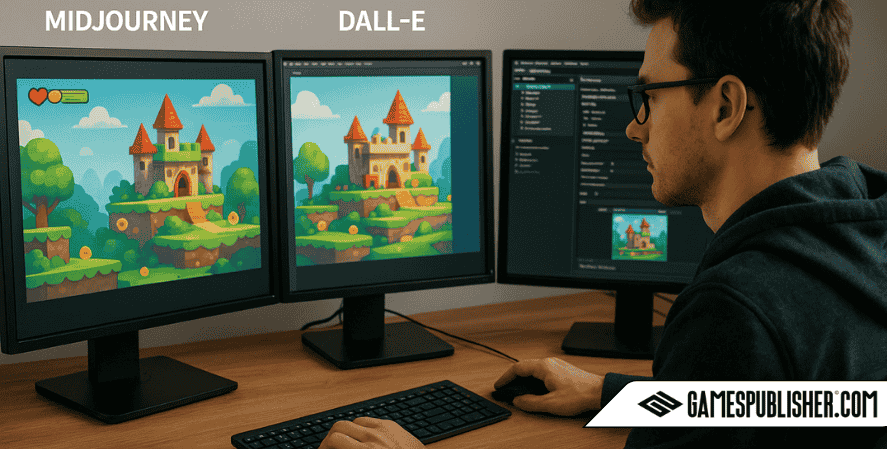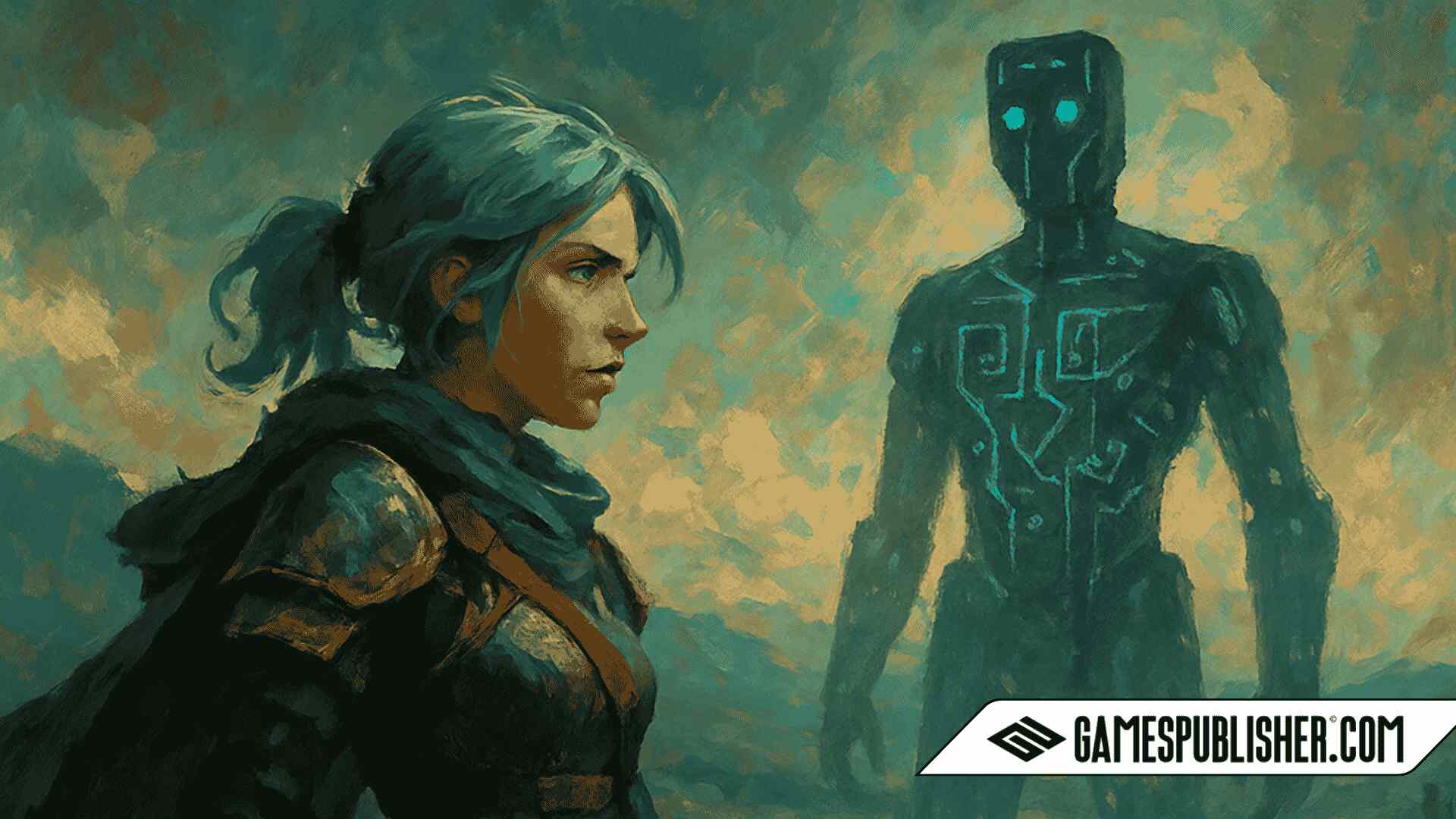The rise of ai generated game technology is changing how artists and developers create video games. What if you could turn a game idea into a stunning world in just a few hours? Today, platforms like Gamespublisher.com are helping game developers and video game publishers keep up with this shift.
AI-generated art is speeding up the creative process. It’s making game development faster, cheaper, and more flexible. However, to use this tech well, developers must understand its power, how it fits into the workflow, and the challenges it brings.
AI Generated Game Art – A New Creative Frontier

An ai generated game uses artificial intelligence to create game art. This includes backgrounds, textures, characters, and props. Rather than drawing or modeling each asset by hand, artists can now use AI to help create what they need.
Midjourney, DALL·E, and Stable Diffusion are among the most commonly used AI tools for transforming written prompts into detailed visuals.
Today, many studios include AI in different stages of their projects. Whether they are creating concept art or final assets, AI fits into many parts of the game development process.
AI Generated Game Assets – Speeding Up the Design Pipeline
From Concept to Execution in Hours
In the past, it took weeks to turn an idea into a complete concept. Now, thanks to ai generated game tools, this can happen in just a few hours. Because of this speed, developers can test ideas earlier and improve them faster.
For example, small studios can now build a Minimum Viable Product (MVP) much quicker. They use ai game generator tools to create early versions of their games. These early builds help them get feedback and move forward without spending too much money.
As a result, faster concepting gives teams more freedom to explore different game genres and test new ideas.
Enhancing Prototyping and Level Design
AI also helps when it comes to building game levels. Developers can use AI to fill environments with props, textures, and lighting. This significantly reduces the amount of manual effort required.
Moreover, engines like Unity and Unreal now support AI plugins. These tools help game developers build demo levels and test concepts quickly. Therefore, they can focus on improving gameplay instead of spending hours on visual details.
In video game development, this kind of fast prototyping plays a big role. It helps studios improve their games before full production even begins.
AI Generated Game Characters and Environments

Designing Unique NPCs and Worlds with AI
AI generated game tools are great for creating Non-Playable Characters (NPCs) and unique game worlds. Artists use detailed prompts to guide the AI and get results that match the game’s story or theme.
For instance, developers can now create entire cultures, costumes, and environments with just a few lines of text. This works especially well for fantasy, sci-fi, or historical games where the world needs to feel deep and believable.
AI also helps game designers maintain a unified visual style throughout characters, environments, and objects. This helps build a believable world without needing a huge art team.
Customization vs. Control – Balancing Creativity and Constraints
Even though AI helps a lot, it doesn’t always get things right. Developers often need to adjust the AI’s results to match their vision. This is where prompt writing and manual edits become important.
Still, the key is balance. AI can do the heavy lifting, but artists still guide the creative process. They make sure the game looks and feels the way they want. With experience, teams learn how to work with AI effectively instead of relying on it completely.
Ethical and Legal Implications of AI Generated Game Art
Ownership of AI-Generated Assets
One big question around ai generated game art is ownership. Who owns the image—the developer who typed the prompt or the company that built the AI?
Each tool has its own rules. For example, some platforms allow full commercial use, while others keep certain rights. Therefore, game publishers need to check the terms before using AI art in their games.
By understanding these terms, developers can protect their projects and avoid legal trouble.
Originality and the Risk of Plagiarism
AI tools learn from existing images and artwork online. Sometimes, they may copy parts of those works without meaning to. This creates a risk of accidental plagiarism.
To avoid this, many teams review the output by hand. They also use filters and tools that check for reused or copyrighted content. These steps help ensure the game stays original and avoids legal issues.
As ai in gaming industry grows, developers must pay attention to legal and ethical rules.
AI Generated Game Art in Indie vs. AAA Studios

Leveling the Playing Field for Indie Developers
Ai generated game tools are a big win for indie developers. These small teams don’t have huge budgets. With AI, they can create top-quality assets fast and at a much lower cost.
This lets them compete with large studios. They can build games in many video game genres, from horror to platformers, with strong visuals.
Now, games with good AI don’t need millions of dollars. All they need is a clear vision and the right tools.
Augmenting Large Studio Pipelines
Big studios use AI too—but in different ways. They don’t replace their artists. Instead, they use AI to support their teams. AI creates early drafts, helps brainstorm, or builds small assets quickly.
For example, some teams use AI to fill in large environments. Others use it to generate quick ideas that artists can then refine. As a result, their teams can work faster and stay creative.
By using generative ai in video games, studios improve speed without giving up control.
Future Trends in AI Generated Game Art
Ai generated game art keeps getting better. What once looked simple and rough now looks detailed and stylish. In fact, future trends promise even more exciting changes ahead.
Here’s what to expect:
- Better style control: AI can now stick to a game’s unique visual style, making everything look more polished.
- Real-time tools: Engines like Unity and Unreal are adding AI tools into their platforms for faster creation.
- Predictive AI: Soon, AI may suggest assets or designs based on how the game is being built.
- Procedural + AI: When mixed with procedural generation, AI can build entire worlds automatically.
Together, these trends show how fast artificial intelligence in computer games is improving. Developers who stay informed will have an advantage in the market.
Conclusion
The rise of ai generated game tools is changing how games are made. They help developers work faster, save money, and bring more ideas to life. From early sketches to finished artwork, AI makes every step easier.
At the same time, developers must think about legal rules and creative control. It’s important to stay ethical and know how to guide the AI properly.
This is where Gamespublisher.com can help. They support game developers, game designers, and video game publishers as they adapt to this fast-changing world. Whether you’re just starting out or leading a large studio, now is the perfect time to explore what AI can do for your next game.
Loading survey...

